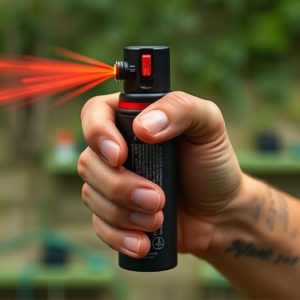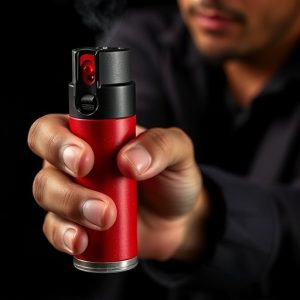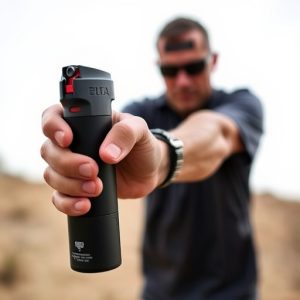Pepper Spray Crowd Control: Wind Direction Tips & Best Practices
The effectiveness of pepper spray for crowd control is significantly influenced by wind direction, w…….
The effectiveness of pepper spray for crowd control is significantly influenced by wind direction, with optimal usage occurring when the wind blows away from the target crowd. Law enforcement must strategically position themselves based on Pepper Spray Wind Direction Tips to enhance their capabilities and ensure safe deployment. Proper training, including understanding airflow dynamics and best practices, allows officers to minimize harm to bystanders while using pepper spray as a last resort. Regular maintenance and awareness of health risks are also crucial for safe and effective crowd control.
In recent years, pepper spray has become a ubiquitous tool in crowd control tactics employed by law enforcement worldwide. This article delves into the intricacies of this controversial substance, offering valuable insights into its effects and limitations. We explore the impact of wind direction on its effectiveness and provide essential tips for police officers aiming to deploy it safely and responsibly. Additionally, we highlight critical safety precautions and potential risks associated with pepper spray use, underscoring the importance of informed decision-making in crowd control strategies.
- Understanding Pepper Spray: Its Effects and Limitations
- The Role of Wind Direction in Pepper Spray Effectiveness
- Best Practices for Police Officers Using Pepper Spray
- Safety Precautions and Potential Risks Associated with Pepper Spray Use
Understanding Pepper Spray: Its Effects and Limitations
Pepper spray, formally known as oleoresin capsicum (OC) spray, is a non-lethal crowd control agent used by law enforcement to temporarily incapacitate individuals and disperse crowds. It works by causing a burning sensation in the eyes, nose, and throat, leading to teary eyes, coughing, and difficulty breathing. The spray’s active ingredient, capsaicin, is derived from chili peppers and is safe for use on humans as it does not leave permanent damage or cause long-term health issues.
While pepper spray can be effective in crowd control, its performance depends heavily on the wind direction tips. Using the wind to your advantage can enhance its effectiveness by ensuring the spray reaches the targeted areas. Conversely, a strong headwind might limit its impact as the spray could blow back onto the officers or disperse too quickly. Therefore, law enforcement personnel need to consider wind conditions when deploying pepper spray, using it in conjunction with other crowd control tactics for optimal results and safety.
The Role of Wind Direction in Pepper Spray Effectiveness
The wind plays a significant role in determining the effectiveness of pepper spray during crowd control. When deploying pepper spray, understanding the wind direction is crucial for optimal results. An ideal scenario arises when the wind blows away from the target crowd, ensuring that the spray does not blow back towards the officers or bystanders. This tactic allows for better visibility and control, enabling police to effectively disrupt and disperse the crowd.
However, in situations where the wind is against the officers, the pepper spray’s reach and impact may be diminished. The wind can carry away the spray before it reaches its intended targets, making it less effective. Therefore, Pepper Spray Wind Direction Tips are essential for law enforcement, suggesting strategic positioning to account for wind patterns, thereby enhancing crowd control capabilities.
Best Practices for Police Officers Using Pepper Spray
When employing pepper spray for crowd control, police officers must adhere to best practices to ensure safety and effectiveness. One crucial aspect is understanding wind direction tips. Officers should consider the airflow to prevent the spray from blowing back towards them or other bystanders. By assessing the wind’s direction, they can strategically deploy the spray, aiming for the ground in front of the crowd to create a barrier without risking exposure.
Additionally, officers should be trained in proper usage techniques, including maintaining a safe distance and allowing sufficient time for the spray to take effect. Regular training sessions and scenario simulations can help police officers enhance their skills, ensuring they use pepper spray responsibly and only as a last resort when other de-escalation methods fail.
Safety Precautions and Potential Risks Associated with Pepper Spray Use
When utilizing pepper spray for crowd control, it’s paramount to consider safety precautions and potential risks. Pepper spray can cause severe irritation to eyes, nose, throat, and lungs, so proper training is essential for officers to ensure they target individuals directly while minimizing exposure to bystanders. Understanding the wind direction tips is crucial; spraying against the wind can result in the chemical spreading uncontrollably, affecting innocent people.
In addition to wind direction, officers must be aware of potential health risks, especially in close quarters. Proper ventilation is necessary to prevent the buildup of pepper spray residue, which can exacerbate breathing difficulties for those with respiratory conditions or asthma. Regular maintenance and inspection of spray equipment are vital to guarantee their functionality and safety.
In conclusion, while pepper spray can be an effective crowd control tool, understanding its dynamics, especially wind direction, is crucial. Officers must adhere to best practices and safety precautions to mitigate risks. By considering these factors and following recommended tips, law enforcement can ensure the safe and strategic use of pepper spray in various scenarios.


